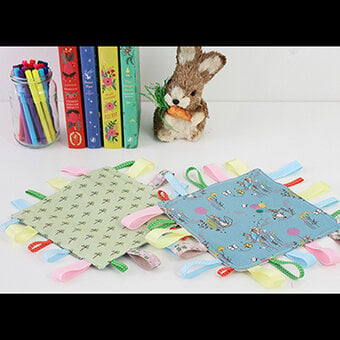How to Make a Seat Pad Cover
Seat pad covers are great for upcycling a piece of furniture or adding a splash of colour to a plain chair. This easy to make seat cushion would make a great addition to your home office.
Follow along with our step-by-step instructions below to add a new lease of life to any chair in your home! Choose whatever fat quarters you like to create an accessory that matches your decor.
You will need
How to make
* Sewing Machine
* Sewing Kit
* Scissors
* Fat Quarters
* Tape Measure
* Sew-On Hook and Loop Tape 20mm x 1m

Lay out the seat pad on to a fat quarter and make a mark on three sides that is half the depth of the seat pad away from the edge. For example, my seat pad is 4cm deep which means that three sides have a 2cm allowance.

For the fourth side use the full depth of the seat pad as an allowance, in my case this is 4cm. Make a small mark on this edge so that you can identify it.
Cut out the fabric and use this piece as a template for the other side.
Measure out the width of the fabric piece and cut the hook and loop to match.
Sew one piece of hook and loop to the right side of the fabric, along the long edge you marked earlier.
Sew the other piece of hook and loop on the other marked long edge but to the wrong side.

Once the hook and loop is attached, line up the two cover pieces right sides together and pin.

Sew around the three edges using a narrow seam allowance, I have used a quarter of an inch on mine
Once you have finished sewing, match the seams on a front corner and pull it flat. Make a mark across the point that is the same width as the depth of your seat pad. For example, my seat pad is 4cm deep and the line I have drawn across the seams is 4cm long.

Do the same for the other corner. You should now have two corners marked and the hook and loop corners should be flat.
Sew along your line using a small straight stitch. Once you have finished both corners, trim away the excess fabric.
Cut two strips of fabric 2 inches wide using the length of the fabric left over from the fat quarters.

Fold them in half lengthways with right sides together.
Stitch down the long edge and leave both ends open.

Turn the tubes right sides out and press flat to make straps.

Sew the ends closed.
Pin the straps between the excess fabric of the seam allowance, making sure that you have an inch or more of length so that they don't tear away.
Sew the straps into the fabric.
Turn the cover right side out, pull out the straps and insert the seat pad.

Close the hook and loop and tuck the overhang down the side gaps.
Your seat pad is now finished! If you've followed along exactly, then you will have a reversible seat pad to spruce up a chair and confuse your cat. You can also attach a bit of ribbon so that you can tie it to a chair back.












